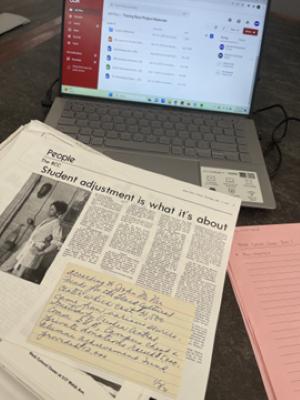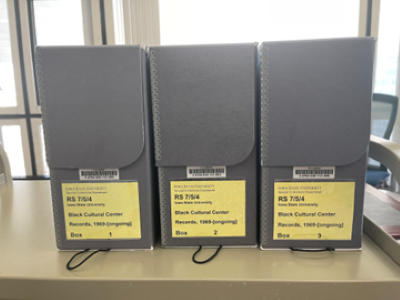Navigating Leadership with the Mapping Leaders of Color at Iowa State University Project
My Tracing Race project, “Mapping Leaders of Color: Leadership as a Force of Change at Iowa State University,” emerged from my close association with young leaders of color within the Bridging Opportunities in Leadership and Diversity (BOLD) learning community at Iowa State University (ISU). Collaborating with Arnold Woods III, M.Ed., the Director of Multicultural Student Success in the College of Liberal Arts and Sciences (LAS DMSS), I guide these students in shaping their leadership identity alongside their identity as students of color in a Predominantly White Institution (PWI).

The focal outcome of this project is an ISU map showing the various leaders of color identified primarily through archival research. Hosted on the project’s website, this map will have ‘pins’ that correspond to a leader. By clicking on a pin, visitors of the website would see a pop-up that shows information for a certain student, staff, or faculty leader. Furthermore, clicking on the leader’s name will take visitors to a separate page with the same information as shown in the pop-up and citations to the references that were used to compile the information provided in the pop-up. Including the references not only allows for transparency, but also provides visitors with the opportunity to do a deeper dive into each leader’s leadership work. The project website will also include information on the methodological process, including the strategies and criteria to identify leaders, identifying leadership styles, and measuring a leader’s impact on the ISU community.
Despite my own history in leadership roles, involvement in the BOLD learning community has opened my eyes to the unique challenges faced by these students as they evolve into leaders within the Iowa State community. Whether through active participation in student organizations or volunteer experiences in the community, their perseverance in leaving an indelible mark on the Iowa State community served as the catalyst for my Tracing Race project. Our classroom discussions delve into multicultural student organizations on campus and the pivotal role they play in fostering leadership opportunities for students of color. We invite faculty and staff of color as guest speakers, allowing our students to glean insights from their experiences managing leadership roles as individuals of color at a PWI.
However, I recognize that these enriching discussions are confined to our learning community. As an educator, my aspiration is to extend similar opportunities to a broader audience within ISU and beyond—educators interested in fostering such dialogues with their students or students of color keen on exploring leadership within the context of a PWI. Moreover, I envision this project evolving into a living document, sustained by the ongoing contributions of students from the BOLD learning community long after my tenure as the Graduate Assistant of the Multicultural Student Success Program.
When I refer to a “living document,” I am alluding to its role as an Open Educational Resource. Beyond capturing the diverse leaders of color, both past and present, at ISU, this project aims to provide educational activities for educators to incorporate into their courses. These reflection-heavy activities, currently in development with guidance from Abbey Elder, Open Access & Scholarly Communication Librarian at Iowa State University, will soon find a place in BOLD learning community courses.
Beyond the professional impetus for this project, I must also share the personal motivation driving my engagement with the Tracing Race initiative. A longstanding aspiration to be a historian/archivist, rooted in my family’s meticulous record-keeping, fueled my eagerness to delve into the histories of leaders of color at ISU. The process of identifying these leaders and evaluating their impact on the ISU community—detailed on my project website—revealed a wealth of captivating narratives. For instance, learning about Dr. George Jackson’s pioneering efforts as the first director of the Office of Minority Student Affairs illuminated the university’s initial endeavors to support underrepresented students, a cause I am actively involved in today. Recognizing that my supervisor’s role as LAS DMSS directly traces back to Dr. Jackson’s efforts deepened my appreciation for this historical connection in my research for the Tracing Race project. This is in line with one of the goals of my project, which is to understand the leaders of colors’ impact at ISU.


My research, utilizing the Special Collections and University Archives resources, instilled in me an appreciation for the meticulous archiving of invaluable information for future researchers. Even if your academic pursuits don’t necessitate a visit to the Special Collections and University Archives, I wholeheartedly recommend ISU students explore it at least once to peruse some of their collections.
To conclude this blog post, I would like to thank the Tracing Race at ISU initiative who has given me the chance to participate in this initiative. It has allowed me to reflect on my own identity as a student of color at a PWI and bring new ideas and resources to the BOLD learning community. Special thanks to the Project Coordinator, Erin Ridnour, for their continued guidance on this project. I look forward to sharing my completed project with you all!